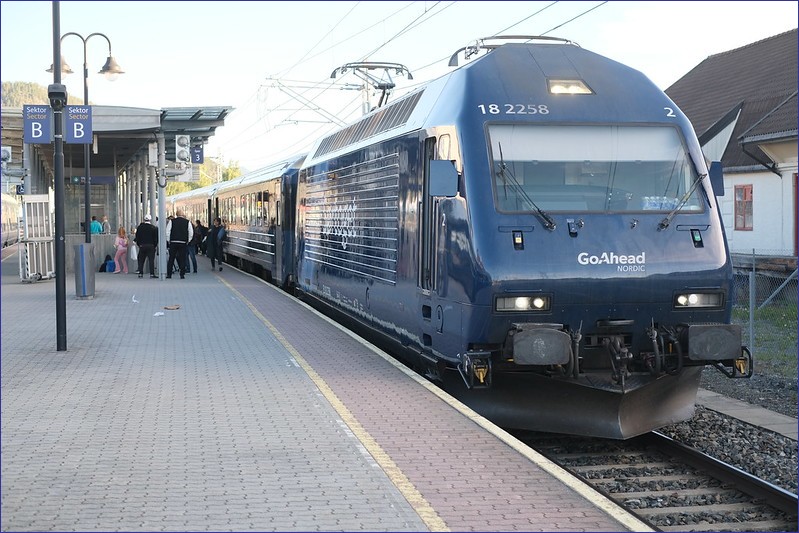Norway is a sparsely populated country with more than 4,100 km of railway tracks. Railway network is well developed but some of the stretches are old and have out-of-date signalling systems. Norway is famous for scenic routes. The Kirkenes–Bjørnevatn Line is second the northernmost railway in the world and Narvik is one of the northernmost towns in the world with scheduled passenger service.
Last updated: 07.07.2025
Table of contents:
1. Domestic trains
2. International trains
3. Night trains
4. Norway by train – what to see
5. Flamsbana
6. Main railway stations
7. Bergensbanen
8. Raumabanen
9. Narrow-gauge railways
10. Funicular railways
11. Railbike railway in Namsos
12. Railway museum in Hamar
13. Chapel in a train car
14. History of the railway in Norway in brief
1. Train travel in Norway – domestic trains
There are suburban, regional and long-distance trains in Norway. Trains connect Norway’s major cities and many routes are famous for stunning landscapes of mountains, lakes, rivers and countryside. Most important railway junction is Oslo Central Station – almost all long-distance trains start and end in Norway’s capital. There are several train operators in Norway – VY, SJ Nord, Flytoget and Go Ahead Nordic. Tickets are expensive, but you cand find low-fare tickets if you book your journey in advance, but most of the cheapest tickets are non-refundable. Interrail and Eurail tickets allows you to save a lot of money.
There also urban and suburban services in Oslo, Trondheim and Bergen.
Passenger operators – timetable, prices, online shops
vy.no – formerly known as NSB. It operates on suburban, regional and long-distance routes. If you buy tickets in advance VY offers “mini pris” fares, significantly cheaper that based-price tickets.
Go-Ahead Nordic – a railway operator officially founded in December 2019. It operates long-distance trains from Oslo to Stavanger, regional trains from Stavanger to Egersund and from Nelaug to Arendal. Go Ahead offers Lavpris promo tickets.
SJ Norge – a subsidiary of SJ Swedish Railways. It operates trains from Trondheim to Oslo and Bodø , regional trains in Nordland and Trøndelag regions, the Dovre line, the Rauma line, and the Røros line but also international trains.
Flytoget – the company operates passenger trains from Oslo city center to Gardermoen International Airport. Some trains are extended to Drammen. Trains from the airport to the center run 24 hours a day, almost every 10 minutes throughout the day, and every 20 minutes at night. The fastest trains cover the route in 19 minutes. Railway line to the airport was opened on 22 August 1999. Rolling stock fleet was inherited from NSB.
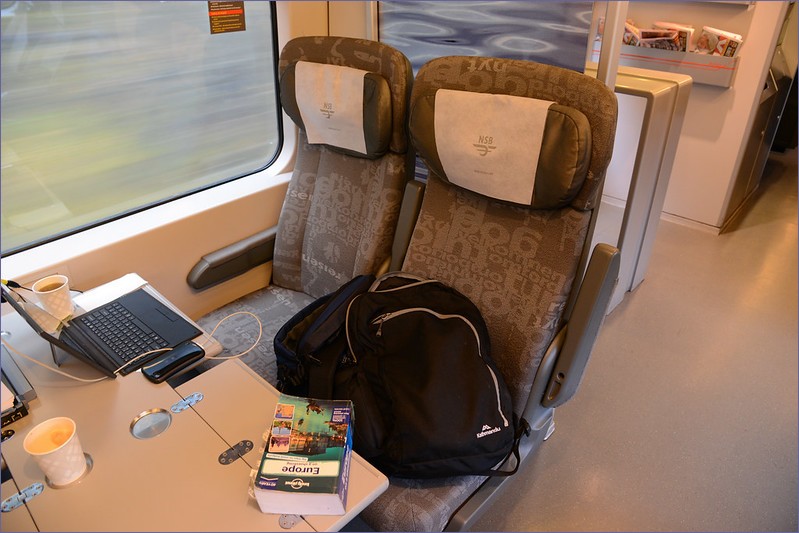
2. Night trains in Norway
There are overnight trains between largest Norwegian cities. Trains are comprised of seating carriages, sleeping cars and cafeteria carriage. Passengers who travel in sleeping cars can buy a breakfast upon arrival in Oslo or Bergen in partner hotels with discount.
Surcharge for sleeping compartment is expensive, but cheaper than accomodation in low-class hotel.
Night trains in Norway run on the following routes:
Oslo – Stavanger (Go Ahead Nordic)
Oslo – Bergen (VY)
Trondheim – Bodø (SJ Norge)
Oslo – Trondheim (SJ Norge)
SJ Norge offers also Premium Pluss class carriages with reclining seats. The reclining seats can be reclined 45 degrees back and free blanket is provided. Passengers have free access to warm drink vending machine, water and snacks are available during the whole journey.
Night trains typically include a bar car, where snacks can be purchased even in the middle of the night.
In recent years, new and even more comfortable sleeping cars have been introduced on the Oslo – Trondheim and Oslo – Bergen routes.
Couchette cars have six-person compartments. You must reserve the entire compartment, so this option is mainly intended for families or groups traveling together. A solo traveler can book the entire compartment, but it will be very expensive.
Sleeping cars in Norway feature two-person compartments. Solo travelers are required to book the entire compartment when traveling on SJ Norge and GoAhead trains. These cars are very comfortable, but also quite costly. Toilets are located at both ends of the cars. Showers and breakfast are available at partner hotels at a discounted rate.
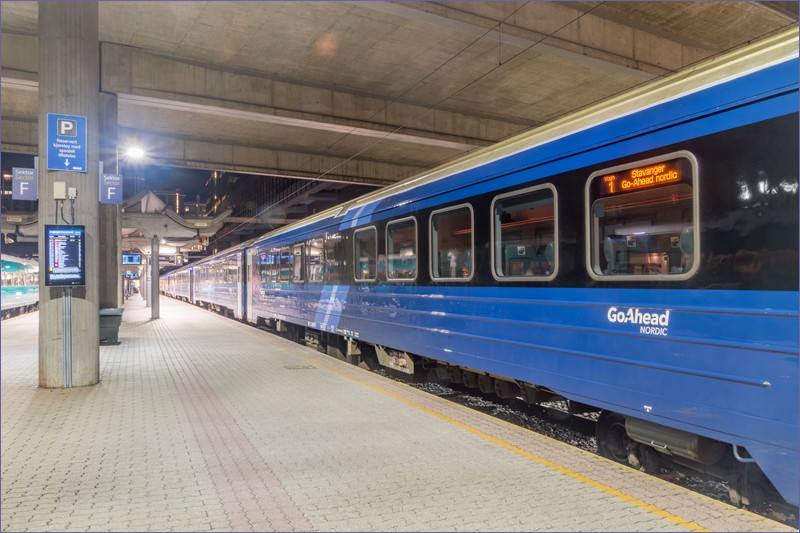
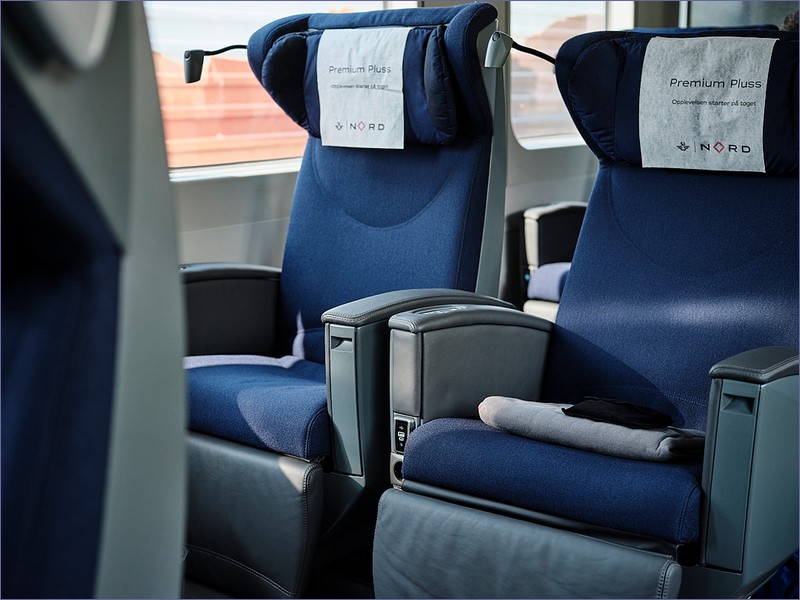
3. Train travel in Norway – international trains
Norway has a railway connections with Sweden. Offer for passengers has improved in recent years. There are long-distance trains from Oslo to Gothenburg and from Oslo to Stockholm, overnight train from Stockholm to Narvik and regional trains from Trondheim to Storlien.
Timetable, tickets and prices:
vy.no – tickets for trains Oslo – Gothenburg and Trondheim – Storlien
sj.se – tickets for trains Oslo – Stockholm and Stockholm – Narfik
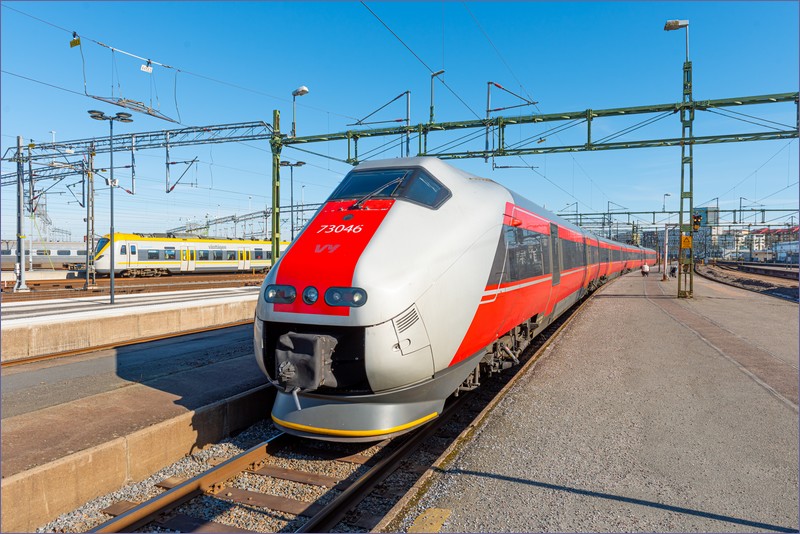
4. Norway by train – what to see
There are many interesting places in Norway, but trains serves only some of them. If you want to explore Norway by train, you can easily reach largest cities, but you need to take a bus to many popular nature attractions or ferry to islands.
Oslo – the capital of Norway. A perfect destination for a weekend getaway. Highlights include the Royal Palace, Akershus Fortress, the Holmenkollen ski jump, and numerous museums.
Bergen – the second-largest city in Norway and, for many centuries, the country’s most important urban center. It’s worth strolling through the Bryggen district, visiting the Fish Market, taking the funicular to Mount Fløyen, and exploring the open-air museum located 5 km from the city in Sandvik.
Stavanger – a medium-sized city known for its offshore oil and gas industry. The Old Town has been preserved with over 170 wooden houses. Stavanger also offers a couple of interesting museums. The most popular museums include the Stavanger Museum, the Norwegian Petroleum Museum, and the Canning Museum, which reflects the city’s history as a center of sardine canning.
Trondheim – Norway’s third-largest city by population. Must-see attractions include the majestic Nidaros Cathedral, the Archbishop’s Palace, old warehouses along the river running through the city center, and the well-kept open-air museum on the outskirts.
Lillehammer – the city that hosted the 1994 Winter Olympics. Highlights include the ski jumps, the Olympic Museum, and the Maihaugen open-air museum, which also houses the Norwegian Postal Museum.
Røros – a former mining town with well-preserved wooden architecture that delights visitors from around the world.
Hamar – an architecturally average city, but worth a visit for the Norwegian Railway Museum.
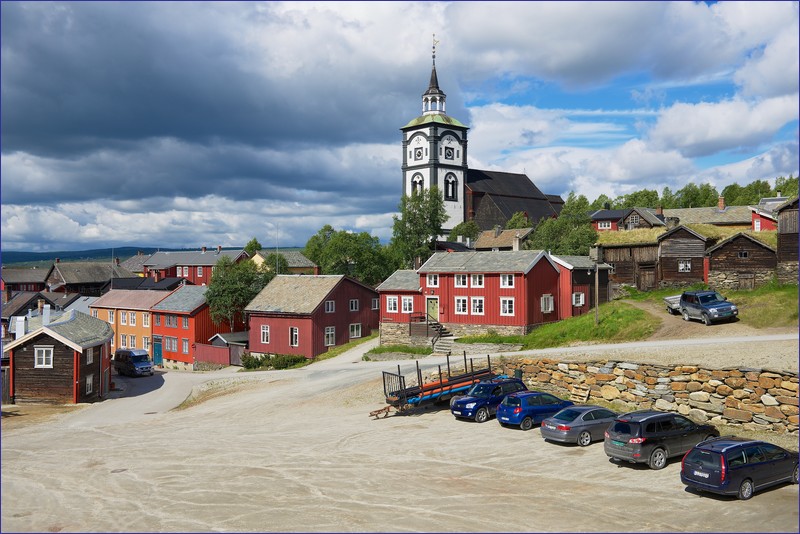
5. Flamsbana
One of the most popular tourist attraction in Norway is Flamsbana – railway line from Myrdal to Flam. Length of the route is only 20 km but it’s the one of the steepest railways in the world. Construction of the line started in 1920 line and the line was finished in 1940. Four years later it was electrified. In 1990s the line was nearly closed. Now it’s an almost exclusively tourist service famous among tourists and railway enthusiasts from all over the world. Trains are operated by Vy on behalf of Flåm Utvikling.
The elevation difference betwen start and end station is 866 meters. The railway line has eleven stations twenty tunnels and one bridge. The maximum gradient is 5.5 percent.
Fares are considerably higher than on other train routes but amazing views are worth the money. Round trip lasts about two hours.
In the off-season, there are 4 trains a day in each direaction, and in the summer season, 9-10 trains a day in each direction.
Myrdal station is located on Oslo – Bergen route.
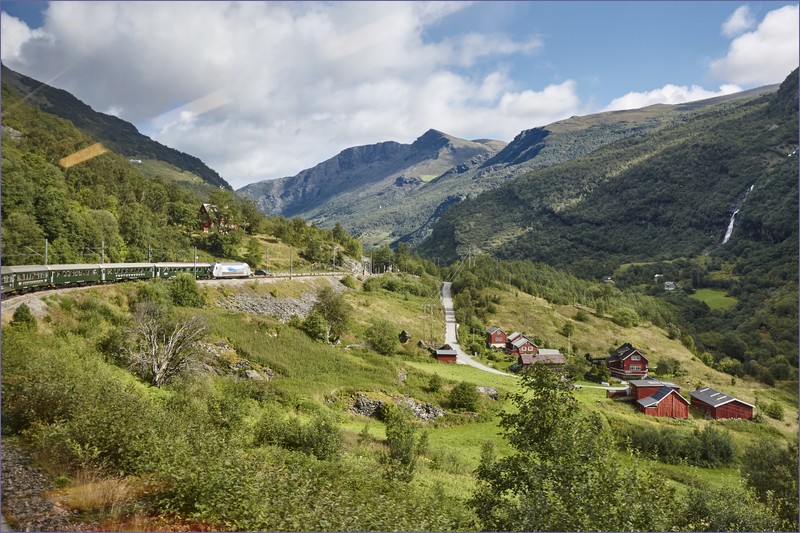
6. Train travel in Norway – main railway stations
Train stations in Norway are generally clean and well-maintained. Most beautiful station buildings are in Bergen, Levanger and Hamar. Usually important train stations are located in the city center and are well connected with interurban and long-distance buses as well as local public transport. Toilets and luggage lockers are often paid only by card – cash is not accepted.
Bergen – one of the most beautiful railway stations in Norway. It is located on the east side of the city centre. The station building, designed by Jens Zetlitz Monrad Kielland in the National Romantic style, was opened in 1913 along with Bergen Line. The station is connected by bus terminal by footbridge. The light rail stop “Nonneseter” is situaded right outside the station. Light rail called “Bybanen” connects Bergen train station with Bergen Airport, Flesland.
Bodø – the station located in the center of the town of Bodø. The station building opened in 1962 houses waiting room, ticket office, ticket vending machines, luggage lockers and hostel. Ferry terminal is located 150 meters from the station. The station is the terminus of the Nordland Line.
Oslo Central Station (Oslo S) – the main railway station in Oslo and the largest railway station in the country. The station has two buildings – the original Oslo East historic building and the newer main building for Oslo Central Station and was officially opened opened by King Olav V on 30 May 1980. It has connection to all five subway lines can be done through Jernbanetorget subway station. Trams and city buses stop outside the station at Jernbanetorget.
Stavanger – terminus of the Sørlandet Line. The station was opened in 1878 when the railway line from Stavanger to Egersund was completed. The station complex consits also water tower and warehouse. It is owned by Bane NOR. Trains to Stavanger are currently operated by Go Ahead. The last section of the railway line between Stavanger and Oslo was inaugurated in 1944. There is a bus terminal at the station, and boat and ferry port nearby.
Trondheim (Trondheim S) – the railway station opened in 1882. It is situated in the city centre. It serves four railway lines: railway lines: Dovrebanen, Rørosbanen, Meråkerbanen and Nordlandsbanen. Bus terminal is at the station.Ferry terminal Pirterminalen is located 500 – 600 meters from the station. There are trains from Trondheim to the airport.

7. Bergensbanen
The railway line connecting Oslo and Bergen is considered one of the most beautiful railway routes in Europe. The long-distance train route from Oslo to Bergen passes through one of the largest plateaus in Europe, Hardangervidda, and runs for a stretch approximately 100 meters above the tree line. The train climbs up to an elevation of 1,237 meters above sea level. The construction of the Bergensbanen was a major challenge for engineers, as the route required the building of 182 tunnels with a total length of 73 kilometers—including one tunnel reaching 10 km in length—as well as around 300 bridges crossing numerous streams. The line was electrified in 1964. The journey along this 400 km stretch takes around 6.5 hours. Trains to Bergen operate during both the day and night. The route passes through mountainous, wild terrain with very sparse settlements.
The Bergensbanen railway is famous for its breathtaking scenery, though I have come across opinions from passengers who felt disappointed and believe it is not as spectacular as guidebooks and websites claim.
Located along the railway, Finse station (1,222 meters above sea level) is the highest railway station in Norway. A small railway museum is located at the station. In the area around Finse and Myrdal, bike trails known as the Railway Road (Rallarvegen) have been marked out, following paths once used by railway workers to transport materials during the construction of the railway line.
8. Raumabanen
All Norwegian railway routes are considered among the most beautiful in the world. According to travel guides, the most scenic of them is the so-called Raumabanen – the railway line between Dombås and Åndalsnes stations. The line is approximately 115 kilometers long, and the journey takes about an hour and a half. In addition to stunning views, one of the main attractions along the route is the so-called Troll Wall, where the train supposedly stops for a photo break (this information is unconfirmed). This is the very line featured in the film Harry Potter and the Half-Blood Prince.
The railway follows the Rauma River. The elevation difference is 655 meters, and the train crosses 32 bridges and passes through six tunnels along the way. Among the bridges, the Kylling Bridge (Kylling Bru) is especially noteworthy – it is the most photographed bridge in Norway.
During the summer season, special retro trains operate on the Bjorli–Åndalsnes section.
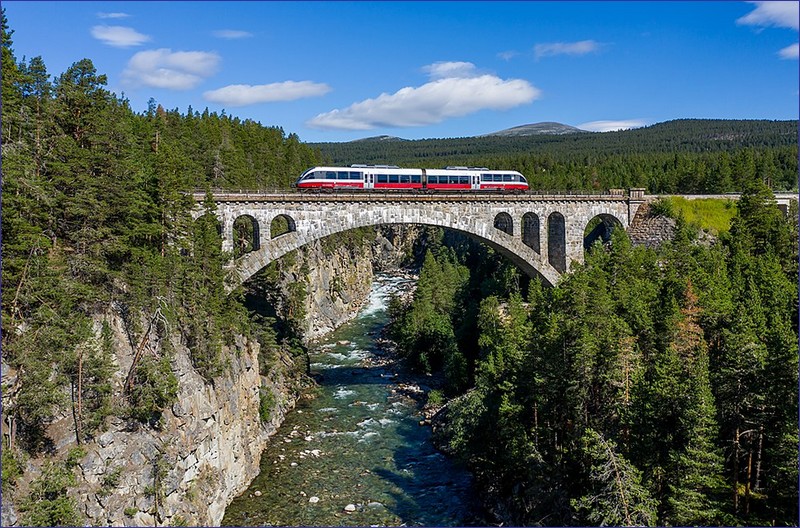
9. Narrow-gauge railways in Norway
There are a few narrow-gauge railways in Norway. These railways are usually run only in season from mid-June to mid-September on weekends.
Most popular narrow-gauge railways:
Lommedalsbanen – a short train rides on the route Gundershogget – Smutterud.
Setesdalsbanen – steam railway running on the Grovane-Røyknes route (8 km)
Thamshavnbanen – a 22-kilometer long narrow-gauge railway in Løkken operates as part of the ORKLA Industrimuseum.
Narrow-gauge railways in Norway
10. Funicular railways in Norway
There is an only one operational funicular in Norway.
Fløibanen – a funicular railway that carries tourists from the city center to the top of Mount Fløyen (320 meters above sea level), offering a beautiful panoramic view of Bergen and the bay. At the summit, there is a café and a souvenir shop. Numerous walking trails start near the upper station, winding through hills and lakes. The ride to the top takes 5–8 minutes. The lower station is just a 2-minute walk from the fish market. Along the way, the carriage stops at Fjellveien, where a scenic walking trail begins, and Skansemyren, located a 5-minute walk from a sports center.
Fløibanen was opened in 1918. It is electrically powered, and there is always a driver in the carriage. Each car can carry up to 120 passengers. The track is 848 meters long, the speed is 4 meters per second, and the rail gauge is 1000 mm. The new carriages were introduced in 2022.
Fløibanen – official website
The remains of the Mågelibanen funicular railway can still be seen in the town of Tyssedal by Lake Vetlavatn. The very steep funicular was built between 1911 and 1912 by AS Tyssefaldene for the transportation of workers and equipment to the mountains in connection with the construction of a 600-meter (1,969 ft) long transfer tunnel between the Øvre and Nedre Bersåvatnet lakes.
In 1956, the funicular was upgraded and gifted by the company to the people of Tyssedal. It was later modernized in 1988. From the late 1990s to the early 2000s, the funicular was also used for tourist transportation. In 2010, the funicular was permanently closed.
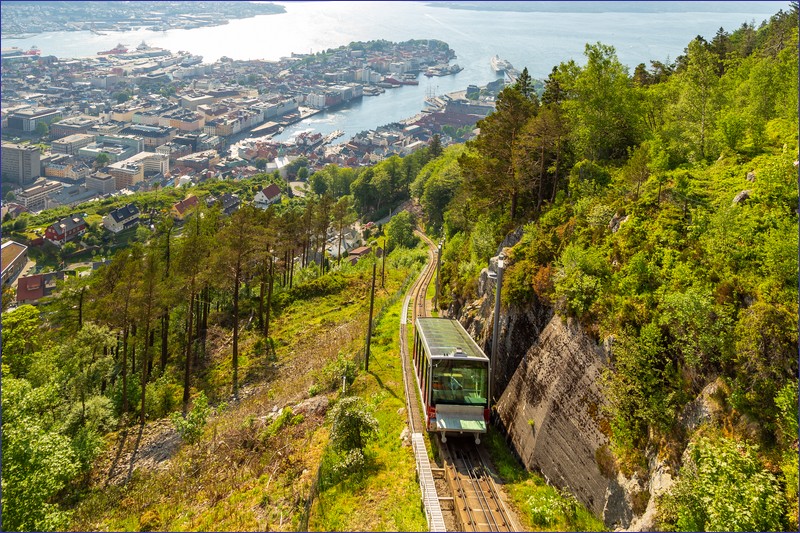
11. Railbike Railway in Namsos
One of the best-known railway attractions is the railbike route on a section of the disused Namsosbanen railway line. During the summer season—usually from early May until the end of August or September—it is possible to rent railbikes for a ride between Namsos and Grytøya. The route is 6 kilometers one way and runs along the Namsen River, through forests and tunnels.
The Namsosbanen railway line, which once connected Namsos and Grong, is 51 kilometers long. Train traffic on the line was suspended in 1978. In 2005, the bridge just beyond Skogmo station was dismantled, which split the railway into two disconnected sections.
12. Railway museum in Hamar
The largest railway museum in Norway is located in Hamar on the route Oslo – Trondheim.
The Norwegian Railway Museum is located 3 kilometers from the railway station. The museum boasts a rich collection of locomotives and carriages dating from 1861 to 1962. On its grounds is also Norway’s oldest railway station building, from 1851. One of the highlights of the collection is the Dovregubben 49C 470 steam locomotive, the largest and heaviest steam engine ever used in Norway. The permanent exhibitions showcase signal equipment, railway uniforms, archival photographs, and documents. During the summer season, visitors can ride vintage trains on a short railway line of several hundred meters. The museum also features a children’s playground and a seasonal miniature railway.
Norwegian Railway Museum – official profile (Facebook)
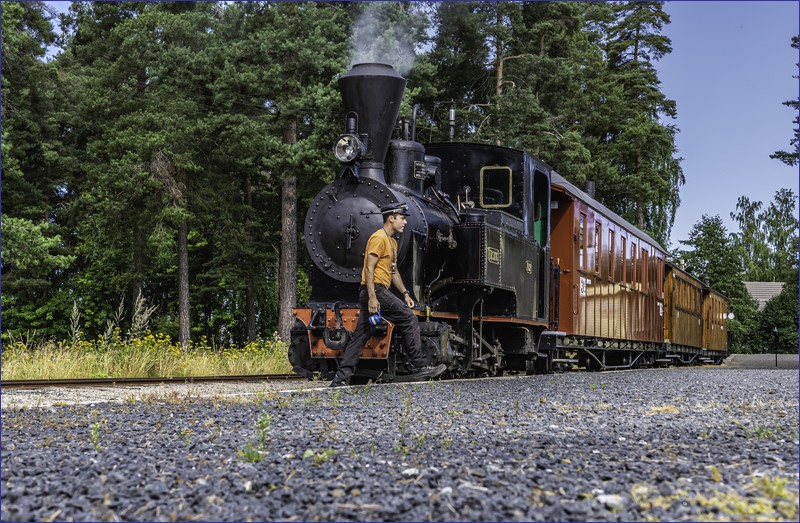
13. Chapel in a Train Car
An unusual use was found for one of the Intercity train cars retired from service by the Norwegian State Railway. In 2003, the rail operator donated the car to the church. On June 10, 2003, the car, located in Åndalsnes, was consecrated by a bishop in the presence of the royal couple, and since then it has served worshippers as a chapel.
The car is stationed at Åndalsnes railway station, the final stop on the Rauma line. The original interior and seating have been preserved, and a small library is available. A portion of the car has been sectioned off as a chapel with an altar. Entry is free of charge.
14. History of the railway in Norway in brief
The first railway in Norway between Oslo and Eidsvoll was opened in 1854. The line was primarily used to move lumber from Mjøsa to Oslo, but passenger trains also ran.
In the period between the 1860s and the 1880s a numerous railway lines were constructed – mainly minor railways and small isolated railways in Central and Western Norway.
In 1875 urban railway started in Oslo. Initially it was a horse-drawn railway, electric cars were introduced in 1894. Urban railways were constructed also in Bergen (1897) and Trondheim (1901)
In 1883 the entire main railway network was taken over by Norwegian State Railways (NSB). Minor railways were operated by private companies.
On 27 November 1909 railway line from Oslo to Bergen was opened.
In August 2023 some of the railway lines were severed by floodwater.
Related articles
